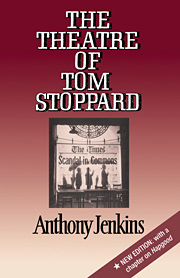6 - Ethics and manners
Published online by Cambridge University Press: 08 January 2010
Summary
After Travesties, Stoppard changed tack. To write anything is a chancy business: a combination of calculated intent, lucky accident, and inspired connections. Stoppard has himself described the way he often starts with an image, like the dead body in Inspector Hound or the collapsing human pyramid of Jumpers, and then chips away at it until the play's ultimate pattern explains his initial picture. But for a playwright there then comes the problem of conveying that pattern to a person sitting in row F. The near-débâcle of Rosencrantz at Edinburgh had shown how vulnerable a script is to actors and director. And though Stoppard could later command the resources of the National Theatre or the Royal Shakespeare Company and, from Jumpers on, the directorial skills of Peter Wood, his particular brand of theatrical audacity was not easy to bring off. Daring to break the action of Travesties with Cecily's extended lecture on the history of the Russian Revolution and then, as the audience recovered, to discountenance them still further with the prosaic Lenins and the ladies' rhythmical “Mr Gallagher and Mr Shean” sparring match proved too confusing on the stage, so out went most of Cecily's sermonette. Understandably, in an interview just after that première, Stoppard acknowledged the riskiness of such theatrical display: “ideally what I'd like to write now is something that takes place in a whitewashed room with no music and no jumping about, but which is a literary piece – so that the energy can go into the literary side of what I do. I'd like to write a quiet play.
- Type
- Chapter
- Information
- The Theatre of Tom Stoppard , pp. 125 - 153Publisher: Cambridge University PressPrint publication year: 1989



